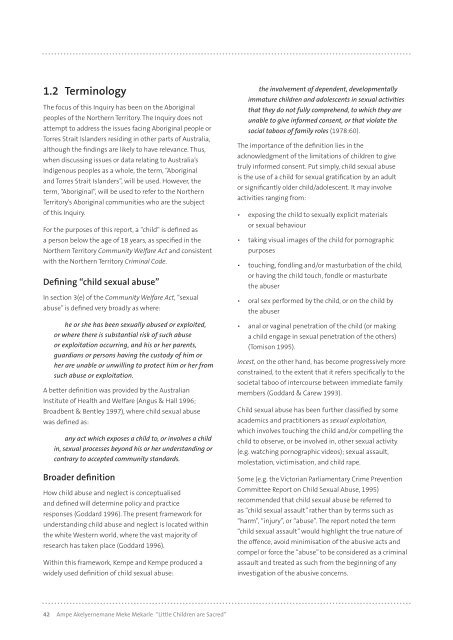bipacsa_final_report
bipacsa_final_report
bipacsa_final_report
Create successful ePaper yourself
Turn your PDF publications into a flip-book with our unique Google optimized e-Paper software.
1.2 Terminology<br />
The focus of this Inquiry has been on the Aboriginal<br />
peoples of the Northern Territory. The Inquiry does not<br />
attempt to address the issues facing Aboriginal people or<br />
Torres Strait Islanders residing in other parts of Australia,<br />
although the findings are likely to have relevance. Thus,<br />
when discussing issues or data relating to Australia’s<br />
Indigenous peoples as a whole, the term, “Aboriginal<br />
and Torres Strait Islanders”, will be used. However, the<br />
term, “Aboriginal”, will be used to refer to the Northern<br />
Territory’s Aboriginal communities who are the subject<br />
of this Inquiry.<br />
For the purposes of this <strong>report</strong>, a “child“ is defined as<br />
a person below the age of 18 years, as specified in the<br />
Northern Territory Community Welfare Act and consistent<br />
with the Northern Territory Criminal Code.<br />
Defining “child sexual abuse”<br />
In section 3(e) of the Community Welfare Act, “sexual<br />
abuse” is defined very broadly as where:<br />
he or she has been sexually abused or exploited,<br />
or where there is substantial risk of such abuse<br />
or exploitation occurring, and his or her parents,<br />
guardians or persons having the custody of him or<br />
her are unable or unwilling to protect him or her from<br />
such abuse or exploitation.<br />
A better definition was provided by the Australian<br />
Institute of Health and Welfare (Angus & Hall 1996;<br />
Broadbent & Bentley 1997), where child sexual abuse<br />
was defined as:<br />
any act which exposes a child to, or involves a child<br />
in, sexual processes beyond his or her understanding or<br />
contrary to accepted community standards.<br />
Broader definition<br />
How child abuse and neglect is conceptualised<br />
and defined will determine policy and practice<br />
responses (Goddard 1996). The present framework for<br />
understanding child abuse and neglect is located within<br />
the white Western world, where the vast majority of<br />
research has taken place (Goddard 1996).<br />
Within this framework, Kempe and Kempe produced a<br />
widely used definition of child sexual abuse:<br />
Ampe Akelyernemane Meke Mekarle “Little Children are Sacred”<br />
the involvement of dependent, developmentally<br />
immature children and adolescents in sexual activities<br />
that they do not fully comprehend, to which they are<br />
unable to give informed consent, or that violate the<br />
social taboos of family roles (1978:60).<br />
The importance of the definition lies in the<br />
acknowledgment of the limitations of children to give<br />
truly informed consent. Put simply, child sexual abuse<br />
is the use of a child for sexual gratification by an adult<br />
or significantly older child/adolescent. It may involve<br />
activities ranging from:<br />
• exposing the child to sexually explicit materials<br />
or sexual behaviour<br />
• taking visual images of the child for pornographic<br />
purposes<br />
• touching, fondling and/or masturbation of the child,<br />
or having the child touch, fondle or masturbate<br />
the abuser<br />
• oral sex performed by the child, or on the child by<br />
the abuser<br />
• anal or vaginal penetration of the child (or making<br />
a child engage in sexual penetration of the others)<br />
(Tomison 1995).<br />
Incest, on the other hand, has become progressively more<br />
constrained, to the extent that it refers specifically to the<br />
societal taboo of intercourse between immediate family<br />
members (Goddard & Carew 1993).<br />
Child sexual abuse has been further classified by some<br />
academics and practitioners as sexual exploitation,<br />
which involves touching the child and/or compelling the<br />
child to observe, or be involved in, other sexual activity<br />
(e.g. watching pornographic videos); sexual assault,<br />
molestation, victimisation, and child rape.<br />
Some (e.g. the Victorian Parliamentary Crime Prevention<br />
Committee Report on Child Sexual Abuse, 1995)<br />
recommended that child sexual abuse be referred to<br />
as “child sexual assault” rather than by terms such as<br />
“harm”, “injury”, or “abuse”. The <strong>report</strong> noted the term<br />
“child sexual assault” would highlight the true nature of<br />
the offence, avoid minimisation of the abusive acts and<br />
compel or force the “abuse” to be considered as a criminal<br />
assault and treated as such from the beginning of any<br />
investigation of the abusive concerns.


